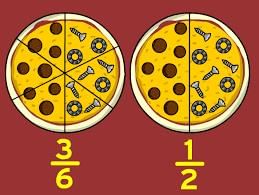Class 8 Exam > Class 8 Notes > Year 8 Mathematics IGCSE (Cambridge) > Fractions
Fractions | Year 8 Mathematics IGCSE (Cambridge) - Class 8 PDF Download
Simplifying Fractions
- Definition: Simplifying a fraction means reducing it to its lowest terms.
- Method: Divide both the numerator and the denominator by their greatest common divisor (GCD).
- Example:
- Original Fraction: 12/18
- GCD of 12 and 18 is 6.
- Simplified Fraction:


Operations with Fractions
Addition and Subtraction
- Find a common denominator, then add or subtract numerators.
- Example:

Multiplication and Division
- Multiply numerators and denominators directly for multiplication; invert and multiply for division.
- Example:

Question for FractionsTry yourself: What is the simplified form of the fraction 24/36?View Solution
Comparing and Ordering Fractions
Comparing Fractions
- Compare fractions by finding a common denominator if necessary.
- Example: Compare 2/3 and 3/4.
- Find common denominator (12):

Ordering Fractions
- Arrange fractions from smallest to largest by comparing them.
- Example: Order

- Compare directly or find common denominators.
Summary
These detailed chapter notes provide a comprehensive understanding of fractions, covering simplification, operations (addition, subtraction, multiplication, division), and methods for comparing and ordering fractions. Each concept is explained thoroughly with practical examples to facilitate learning and application in problem-solving.
The document Fractions | Year 8 Mathematics IGCSE (Cambridge) - Class 8 is a part of the Class 8 Course Year 8 Mathematics IGCSE (Cambridge).
All you need of Class 8 at this link: Class 8
|
42 videos|62 docs|24 tests
|
FAQs on Fractions - Year 8 Mathematics IGCSE (Cambridge) - Class 8
| 1. What is a fraction? |  |
Ans. A fraction is a numerical quantity that represents a part of a whole. It consists of a numerator (the top number) that represents the number of parts being considered, and a denominator (the bottom number) that represents the total number of equal parts in the whole.
| 2. How do you simplify a fraction? |  |
Ans. To simplify a fraction, you need to find the greatest common factor (GCF) of the numerator and denominator and divide both numbers by it. This will reduce the fraction to its simplest form.
| 3. What is an improper fraction? |  |
Ans. An improper fraction is a fraction where the numerator is greater than or equal to the denominator. It represents a value greater than one whole.
| 4. What is a mixed number? |  |
Ans. A mixed number is a combination of a whole number and a proper fraction. It is written as a whole number followed by a fraction. For example, 3 1/2 is a mixed number.
| 5. How do you add and subtract fractions? |  |
Ans. To add or subtract fractions, you need to have a common denominator. If the fractions have different denominators, you need to find a common denominator by multiplying the denominators together. Then, you can add or subtract the numerators and keep the common denominator.
Related Searches

















